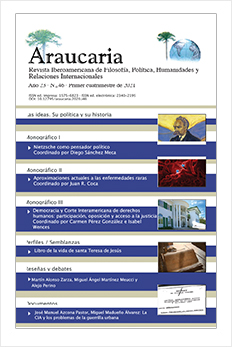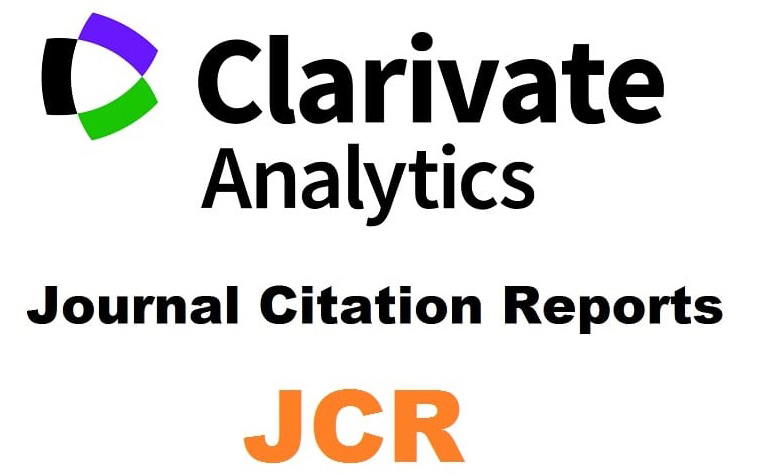Prion diseases: History, diversity, and socioeconomic importance as a paradigm of Rare Diseases
DOI:
https://doi.org/10.12795/araucaria.2021.i46.21Keywords:
Prions, Rare diseases, prions diseasesAbstract
Rare disease are those pathologies that affect a reduced proportion of the population (less than 50 cases per 100 000 people). For this reason, the research on their causes and mechanisms, which is essential to find a way to treat or prevent them, is insufficient. This causes that the patients report a lack of coverage by the health system and the social discrimination that suffering one of these pathologies entails. Among rare diseases, we find the so-called prion diseases or transmissible spongiform encephalopathies. Although they are relatively well-known due to the health crisis provoked by the “mad cow disease” at the end of the last century, there are still many uncertainties about these disorders that affect both animals and humans. This monograph aims at bringing to light the fascinating history and the diversity of prion diseases, which shook the foundations of the biology known before the 1980s by bringing out a new and puzzling type of infectious agent: prions.
Downloads
References
Alper, T. (1972). The nature of the scrapie agent. Journal of Clinical Pathology.Supplement (Royal College of Pathologists), 6, 154-155.
Benestad, S. L., et al. (2016). First case of chronic wasting disease in europe in a norwegian free-ranging reindeer. Veterinary Research, 47(1), 88-016-0375-4. doi:10.1186/s13567-016-0375-4
Bonda, D. J., et al. (2016). Human prion diseases: Surgical lessons learned from iatrogenic prion transmission. Neurosurgical Focus, 41(1), E10. doi:10.3171/2016.5.FOCUS15126
Brown, P. (2009). Reflections on a half-century in the field of transmissible spongiform encephalopathy. Folia Neuropathologica, 47(2), 95-103. doi:12704
Brown, P., et al. (2012). Iatrogenic creutzfeldt-jakob disease, final assessment. Emerging Infectious Diseases, 18(6), 901-907. doi:10.3201/eid1806.120116
Budka, H., et al. (1995). Neuropathological diagnostic criteria for creutzfeldt-jakob disease (CJD) and other human spongiform encephalopathies (prion diseases). Brain Pathology, 5(4), 459-466.
Bueler, H., et al. (1993). Mice devoid of PrP are resistant to scrapie. Cell, 73(7), 1339-1347. doi:0092-8674(93)90360-3
Coca, J. R., et al. (2019). Análisis cualitativo del impacto social y familiar de las encefalopatías espongiformes transmisibles humanas. Revista De Neurología, 69, 242-248. doi:10.33588/ rn.6906.2019122
Cohen, F. E., & Prusiner, S. B. (1998). Pathologic conformations of prion proteins. Annual Review of Biochemistry, 67, 793-819. doi:10.1146/annurev.biochem.67.1.793
Collinge, J., et al. (1996). Molecular analysis of prion strain variation and the aetiology of 'new variant' CJD. Nature, 383(6602), 685-690. doi:10.1038/383685a0
Creutzfeldt, H. (1920). Über eine eigenartige herdförmige erkrankung des zentralnervensystems. Z Gesamte Neurol Psychiatr, 57, 1-19.
Chandler, R. L. (1961). Encephalopathy in mice produced by inoculation with scrapie brain material. Lancet, 1(7191), 1378-1379. doi:10.1016/s0140-6736(61)92008-6
Chesebro, B., et al. (1985). Identification of scrapie prion protein-specific mRNA in scrapie-infected and uninfected brain. Nature, 315(6017), 331-333. doi:10.1038/315331a0
Duffy, P., et al. (1974). Letter: Possible person-to-person transmission of creutzfeldt-jakob disease. The New England Journal of Medicine, 290(12), 692-693.
Duque Velasquez, C., et al. (2015). Deer prion proteins modulate the emergence and adaptation of chronic wasting disease strains. Journal of Virology, 89(24), 12362-12373. doi:10.1128/JVI.02010-15
Erana, H., et al. (2017). Prion-like disorders and transmissible spongiform encephalopathies: An overview of the mechanistic features that are shared by the various disease-related misfolded proteins. Biochemical and Biophysical Research Communications, 483(4), 1125-1136. doi:S0006-291X(16)31430-9
European Commission. (n.d.). Rare diseases. retrieved 2020, nov 7. Https://Ec.Europa.Eu/Health/Non_communicable_diseases/Rare_diseases_en,
FEDER. (n.d.). Federación española de enfermedades raras. Https://Enfermedades-Raras.Org/,
Gajdusek, D. C. (1967). Slow-virus infections of the nervous system. The New England Journal of Medicine, 276(7), 392-400. doi:10.1056/NEJM196702162760708
Gajdusek, D. C., et al. (1967). Transmission and passage of experimenal "kuru" to chimpanzees. Science (New York, N.Y.), 155(3759), 212-214.
Gajdusek, D. C., et al. (1966). Experimental transmission of a kuru-like syndrome to chimpanzees. Nature, 209(5025), 794-796.
Gambetti, P., et al. (2008). A novel human disease with abnormal prion protein sensitive to protease. Annals of Neurology, 63(6), 697-708. doi:10.1002/ana.21420
Gambetti, P., et al. (2003). Sporadic and familial CJD: Classification and characterisation. British Medical Bulletin, 66, 213-239. doi:10.1093/bmb/66.1.213
Gibbs, C. J.,Jr, et al. (1968). Creutzfeldt-jakob disease (spongiform encephalopathy): Transmission to the chimpanzee. Science, 161(3839), 388-389. doi:10.1126/science.161.3839.388
Glatzel, M., et al. (2005). Human prion diseases: Molecular and clinical aspects. Archives of Neurology, 62(4), 545-552. doi:62/4/545
Hadlow, W. J. (2008). Kuru likened to scrapie: The story remembered. Philosophical Transactions of the Royal Society of London.Series B, Biological Scis, 363(1510), 3644. doi:10.1098/rstb.2008.4013
Hill, A. F., et al. (1997). The same prion strain causes vCJD and BSE. Nature, 389(6650), 448-50, 526. doi:10.1038/38925
Hill, A. F., et al. (2003). Molecular classification of sporadic creutzfeldt-jakob disease. Brain, 126(Pt 6), 1333-1346.
Houston, F., & Andreoletti, O. (2019). Animal prion diseases: The risks to human health. Brain Pathology (Zurich, Switzerland), 29(2), 248-262. doi:10.1111/bpa.12696
Huor, A., et al. (2019). The emergence of classical BSE from atypical/Nor98 scrapie. Proceedings of the National Academy of Sciences of the United States of America, doi:201915737
Jakob, A. (1921). Über eigenartige erkrankungen des zentralnervensystems mit bemerkenswertem anatomischem. befunde. (spastische pseudosklerose- encephalomyelopathie mit disseminierten degenerationsherden). Z Gesamte Neurol Psychiatr, 64, 147-228.
Johnson, R. T., & Gibbs, C. J.,Jr. (1998). Creutzfeldt-jakob disease and related transmissible spongiform encephalopathies. The New England Journal of Medicine, 339(27), 1994-2004. doi:10.1056/NEJM199812313392707
Klatzo, I., et al. (1959). Pathology of kuru. Laboratory Investigation; a Journal of Technical Methods and Pathology, 8(4), 799-847.
Konold, T., et al. (2004). Clinical findings in 78 suspected cases of bovine spongiform encephalopathy in great britain. The Veterinary Record, 155(21), 659-666. doi:10.1136/vr.155.21.659
Kovacs, G. G., et al. (2005). Genetic prion disease: The EUROCJD experience. Human Genetics, 118(2), 166-174. doi:10.1007/s00439-005-0020-1
Kretzschmar, H. A., et al. (1995). Codon 178 mutation of the human prion protein gene in a german family (backer family): Sequencing data from 72-year-old celloidin-embedded brain tissue. Acta Neuropathologica, 89(1), 96-98.
Latarjet, R., et al. (1970). Inactivation of the scrapie agent by near monochromatic ultraviolet light. Nature, 227(5265), 1341-1343. doi:10.1038/2271341a0
Liberski, P. P. (2012). Historical overview of prion diseases: A view from afar. Folia Neuropathologica, 50(1), 1-12. doi:18385
Liberski, P. P., et al. (2019). Kuru, the first human prion disease. Viruses, 11(3), 10.3390/v11030232. doi:E232
Linsell, L., et al. (2004). A case-control study of sporadic creutzfeldt-jakob disease in the united kingdom: Analysis of clustering. Neurology, 63(11), 2077-2083. doi:63/11/2077
Mathiason, C. K. (2017). Scrapie, CWD, and transmissible mink encephalopathy. Progress in Molecular Biology and Translational Science, 150, 267-292. doi:S1877-1173(17)30119-9
Minikel, E. V., et al. (2016). Quantifying prion disease penetrance using large population control cohorts. Science Translational Medicine, 8(322), doi:10.1126/scitranslmed.aad5169
Nguengang Wakap, S., et al. (2020). Estimating cumulative point prevalence of rare diseases: Analysis of the orphanet database. European Journal of Human Genetics : EJHG, 28(2), 165-173. doi:10.1038/s41431-019-0508-0
Notari, S., et al. (2014). Transmission characteristics of variably protease-sensitive prionopathy. Emerging Infectious Diseases, 20(12), 2006-2014. doi:10.3201/eid2012.140548
Pattison, I. H., & Millson, G. C. (1961). Scrapie produced experimentally in goats with special reference to the clinical syndrome. Journal of Comparative Pathology, 71, 101-109.
Prusiner, S. B. (1982). Novel proteinaceous infectious particles cause scrapie. Science, 216(4542), 136-144.
Prusiner, S. B. (1989). Scrapie prions. Annual Review of Microbiology, 43, 345-374. doi:10.1146/annurev.mi.43.100189.002021
Saborio, G. P., et al. (2001). Sensitive detection of pathological prion protein by cyclic amplification of protein misfolding. Nature, 411(6839), 810-813. doi:10.1038/35081095
Song, P., et al. (2012). Rare diseases, orphan drugs, and their regulation in asia: Current status and future perspectives. Intractable & Rare Diseases Research, 1(1), 3-9. doi:10.5582/irdr.2012.v1.1.3
Takada, L. T., et al. (2017). Genetic prion disease: Experience of a rapidly progressive dementia center in the united states and a review of the literature. American Journal of Medical Genetics. Part B, Neuropsychiatric Genetics, 174(1), 36-69. doi:10.1002/ajmg.b.32505
Tambuyzer, E. (2010). Rare diseases, orphan drugs and their regulation: Questions and misconceptions. Nature Reviews.Drug Discovery, 9(12), 921-929. doi:10.1038/nrd3275
Tesar, A., et al. (2019). Clinical variability in P102L gerstmann-straussler-scheinker syndrome. Annals of Neurology, 86(5), 643-652. doi:10.1002/ana.25579
Thadani, V., et al. (1988). Creutzfeldt-jakob disease probably acquired from a cadaveric dura mater graft. case report. Journal of Neurosurgery, 69(5), 766-769. doi:10.3171/jns.1988.69.5.0766
Verbeke, W. (2001). Consumer reactions and economic consequences of the BSE crisis. Verhandelingen - Koninklijke Academie Voor Geneeskunde Van Belgie, 63(5), 483-492.
Wang, F., et al. (2010). Generating a prion with bacterially expressed recombinant prion protein. Science, 327(5969), 1132-1135. doi:10.1126/science.1183748
Wickner, R. B., et al. (2015). Yeast prions: Structure, biology, and prion-handling systems. Microbiology and Molecular Biology Reviews : MMBR, 79(1), 1-17. doi:10.1128/MMBR.00041-14
Williams, E. S. (2005). Chronic wasting disease. Veterinary Pathology, 42(5), 530-549. doi:42/5/530
Yuan, A. H., & Hochschild, A. (2017). A bacterial global regulator forms a prion. Science (New York, N.Y.), 355(6321), 198-201. doi:10.1126/science.aai7776
Zlotnik, I., & Rennie, J. C. (1965). Experimental transmission of mouse passaged scrapie to goats, sheep, rats and hamsters. Journal of Comparative Pathology, 75, 147-157.
Downloads
Published
How to Cite
Issue
Section
License
Las ediciones impresa y electrónica de esta Revista son editadas por el Secretariado de Publicaciones de la Universidad de Sevilla, siendo necesario citar la procedencia en cualquier reproducción parcial o total.Salvo indicación contraria, todos los contenidos de la edición electrónica se distribuyen bajo una licencia de uso y distribución “Creative Commons Atribución-NoComercial-SinDerivar 4.0 Internacional”








